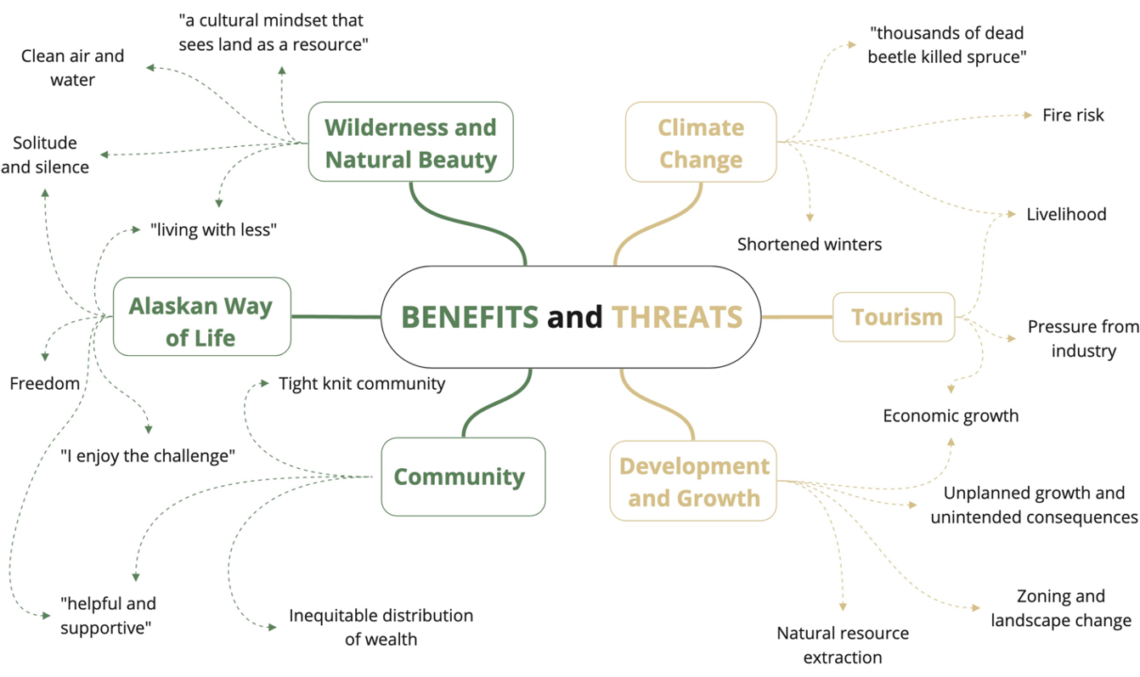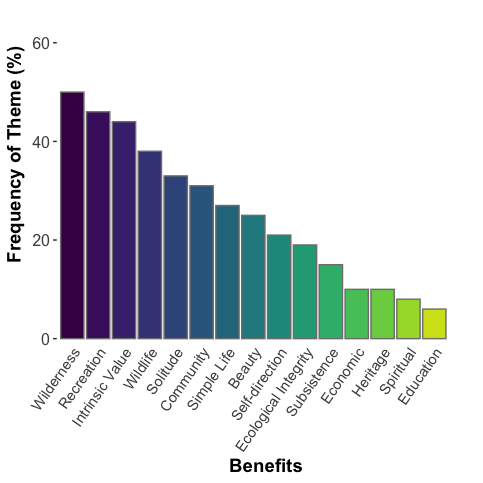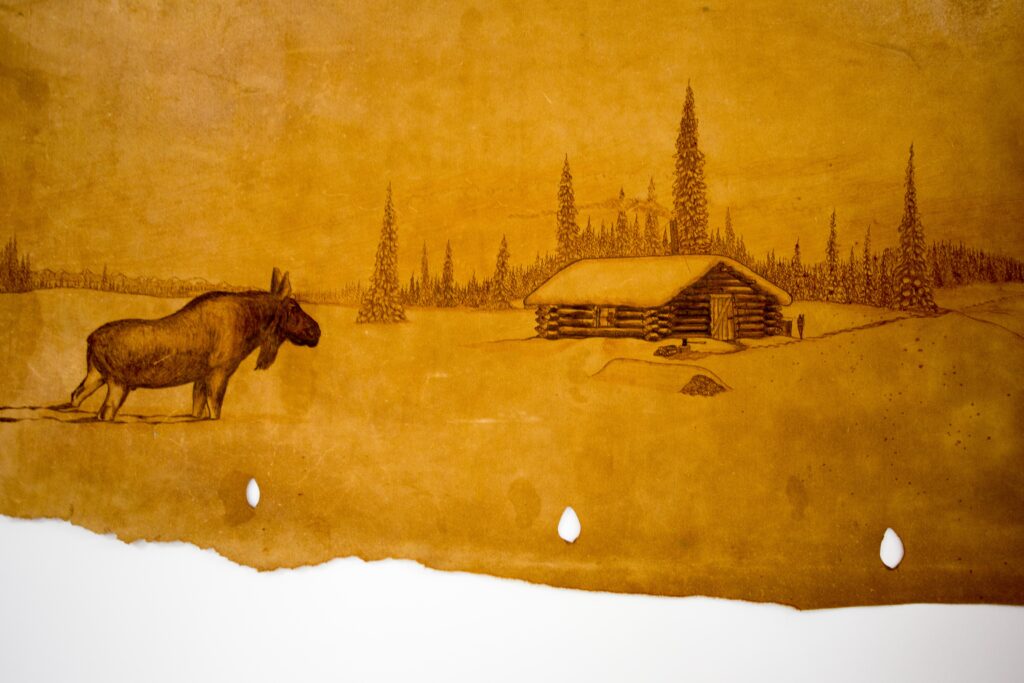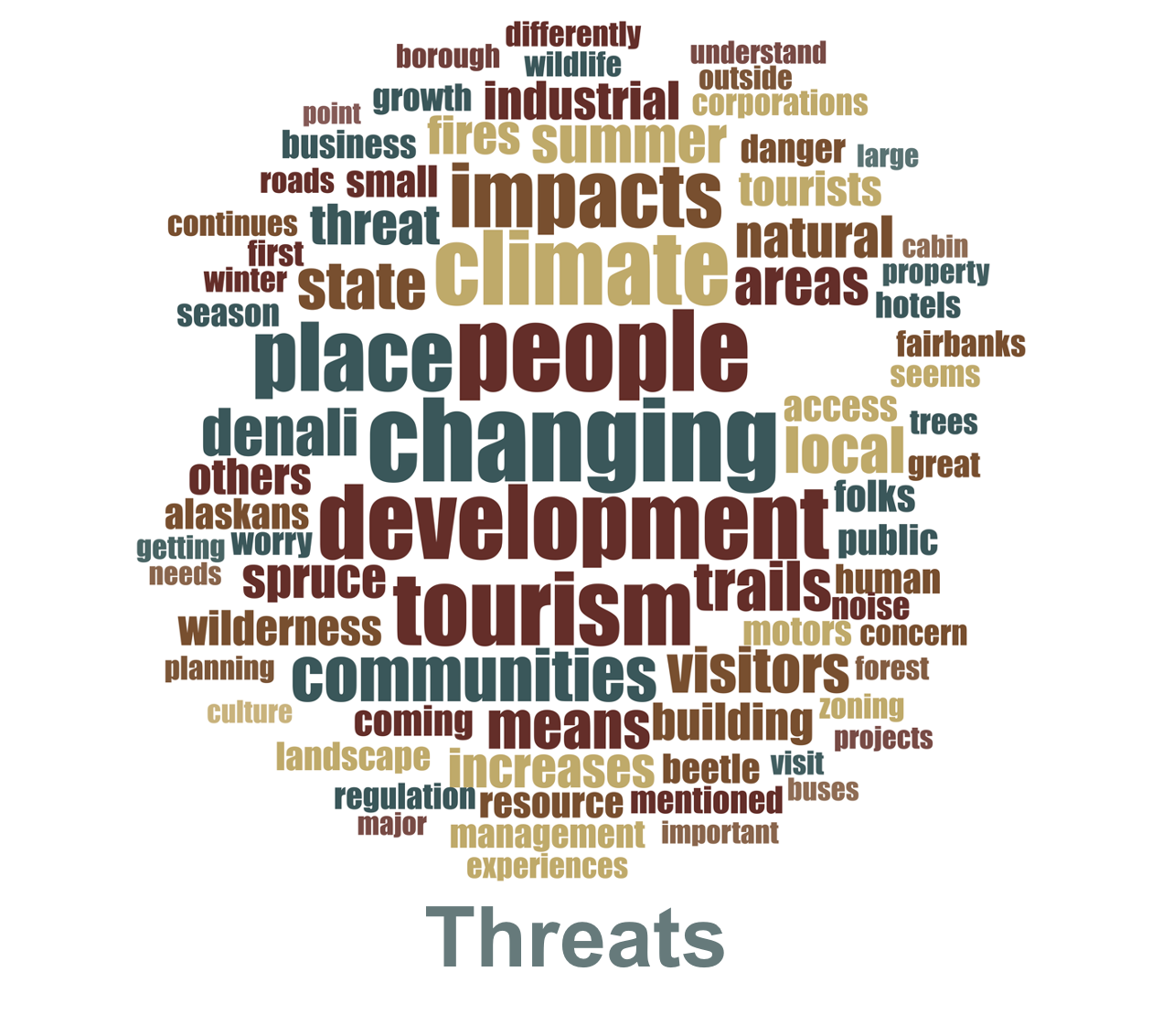
Week 1: Benefits and Threats
Thank you all for participating in the Denali Discussion Forum. Our team has been learning a great deal from each of you and feeling inspired by the thoughtful and interesting ideas that have been shared. In Week 1, there were a total of 118 posts among 38 residents who are participating in the online discussion. We have developed the summary below to reflect on and synthesize all of your exchanges. It is our hope that this summary is both comprehensive, but also nuanced enough to give justice to your perspectives. We would appreciate receiving your feedback on how we are interpreting your ideas. Please provide your reflection in the Forum or by email to share any thoughts you might have about this summary and/or your experiences during Week 1.
Landscape Benefits
Question 1. What are the benefits of living in Interior Alaska and the northern Mat-Su?
Multiple benefits of the Denali region
There was a wide range of benefits associated with the Denali landscape. A total of 15 interconnected benefits were shared in ways that underscored your commitment to protecting special places (see Figure 1). There was overlap across the three groups, though Group A emphasized benefits such as wildness and recreation, beauty, and unique lifestyle (living deliberately, a self-directed life). Group B also emphasized benefits such as wildness and recreation, but also brought up the ideas of solitude, silence, and a dark starry sky. Group C emphasized the intrinsic value of the landscape outside of its benefits to people. As one of you so aptly stated, “How can we possibly put into words the benefits that living in this spectacular place provides?” Although it was challenging to articulate why the Denali landscape was valued, everyone was able to characterize the region in a variety of ways (see Figure 2). We distilled the responses across all three groups into the following categories: 1) Wildness and natural beauty, 2) An Alaskan way of life, and 3) Sense of community.

Wildness and natural beauty
One of the major themes that we observed was around wildness and natural beauty of the Denali landscape. You talked about the importance of wilderness experiences that were unique to the region, as well as solitude, silence, clean air and water, dark starry nights, subsistence and wildlife. Interestingly, several of you emphasized the value of the Denali landscape in and of itself – outside of its delivery of resources – and the corresponding responsibility to “honor” and “preserve” the landscape. You all recognized this framing around the anthropocentric “benefits” of nature used in public land management discussions and also our research:
“I think the framing of this question (and I don’t just mean in this study, this kind of language is everywhere in policy discussion) is kind of reflective of one of the threats: a cultural mindset that sees land as a “resource” existing for us to use however we want.”
We appreciated these sentiments and the general self-awareness that was evident in your responses. Apparent knowledge of the landscape and its features was also notable. Many of you were intimately familiar with different landscape conditions in Alaska and ways they are changing. This knowledge seemed to deepen your connections to places and perceived benefits of the region. After all, Denali “…is not only wilderness, but it is an uncommonly spectacular wilderness… with forest, lakes, muskegs, and rivers with the backdrop of the Alaska Range.”
An Alaskan way of life
We have learned that the array of benefits you see in the Denali landscape support a unique, “Alaskan” way of life. The stories shared about your motivations for moving to Alaska and the history of your experiences emphasized how special the place is and your interests in preserving its inherent character. The rural lifestyles that many of you described bring challenges for living in the region but also close connections with your neighbors. Many of you expressed gratitude for the opportunity to take on labor-intensive tasks such as chopping firewood to get through a long winter. Some of you also mention the ideal of “living with less” or “living deliberately”. Overall, we appreciated how you voiced connection among the unique challenges posed by living in the Denali region, a sense of independence and the ability to lead a self-directed life. For example, one participant stated: “I enjoy the challenge of living in an environment that’s not conventionally convenient (by modern standards) for humans in — both socially and environmentally.”
Many of you also voiced there was a unique freedom in being able to choose from a variety of recreation activities and exploring the landscape was listed an important part of your way of life. For example, one of you shared the following passage that highlighted the access to a range of activities readily available that strengthen your ties to the landscape:
“What I most enjoy is the ability to travel just a short distance and explore wild places. I can float the nearby Susitna River and be in a wild area just a short distance from my house, or go on a multiday trip down the spectacular Chulitna River. Recreational opportunities abound, and also opportunities to feel connected to nature.”
We observed variation in your responses about the Alaskan way of life. Some of you mentioned appreciating modern connivences that were available in the area (e.g., health care facilities, post offices, stores), whereas others purposefully avoided these conveniences and expressed concern that modern conveniences may bring by making the area easier for people to inhabit. Moreover, the values of an Alaskan way of life were strong enough to solicit a comment regarding the artificial contexts experienced by most tourists:
“why are there so many options for “fake” Alaska items and experiences? If the people are coming for a true look at Alaska and what life here means…how can we encourage a more meaningful experience for them, so that they leave knowing what Alaska truly means?”


Sense of community
The deep sense and commitment to community in the Denali region was apparent in many responses from Week 1. This strong sense of community was viewed as complementary to the independence of individuals and solitude provided by the wilderness. For example, one of you shared that, “Our neighbors are more physically spread out than in many places, but the community is the most helpful and supportive I’ve ever encountered.” As a corollary, others shared stories about going to the post office and knowing everyone, or that you could break down on the side of the road and people would be lined up to help.
Diversity in your perspectives on sense of community also emerged. Some of you challenged the notion of a tight-knit community due to factors such as the inequitable distribution of wealth and status. Others expressed concern for Indigenous Alaskans and raised the question of how residents could better center Indigenous voices, as well as other people who are marginalized in the current system.
“People coming from other places and bringing their culture/way of doing things with them as opposed to learning the ropes here…This manifests in being a disrespectful neighbor, disrespectful land use, and disrespectful demands on the community. This is why we end up needing planning and regulation. A good example of this is folks trapping right near popular trails, other folks’ traplines, and neighborhoods where you end up competing with the old time trappers and catching people’s dogs. Sure it’s legal but it’s not respectful.”


Threats (Concern for Landscape Change)
Question 2. As the Denali region changes over the next 30 years, what are the major social or environmental threats that you think will negatively impact the landscape’s ability to provide these benefits to local communities?
Our goal with the second prompt in Week 1 of the Denali Discussion Forum was to understand how you have seen the landscape change and the major threats facing the region over the next 30 years. As with the question about benefits, a variety of threats were highlighted, which illustrated your deep-seated knowledge and concern about landscape change (see Figure 2). Group A emphasized threats such as the lack of true representation by residents in decision-making and the influence of interest groups disconnected from the Denali region. Group B emphasized concerns around infrastructure supporting trail systems (especially multi-use trails) and concerns about the mismanagement and misuse of protected areas. Group C emphasized threats from climate change and how environmental issues were framed in decision-making processes. All three groups expressed concerns about tourism. Although there was much variation in your responses, we distilled your thoughts into three broad categories related to: 1) climate variability, 2) ambivalence toward tourism, and 3) development and growth.
Climate variability
Climate variability emerged from your responses in Week 1 as a key pattern and salient issue in the region. Many of you have noticed changes insofar as shortened winters and impacts on your abilities to pursue your favorite recreational activities. You also lamented, “the negative impacts [climate variability] is having on human safety, species’ chances of survival, and subsistence abilities.” Interestingly, many shared that warming temperatures were connected to other facets of landscape change. For example, you brought up spruce beetles, fire risk, melting permafrost, and sinkholes affecting the road systems as threats interconnected with climate change. A particularly pressing concern was spruce beetles and was nicely summarized in the following passage: “The thousands upon thousands of dead beetle killed spruce have impacted the landscape immensely. We fear walking through the woods when it is windy for so many of those trees break off and fall fast in the wind. Also, when it gets real hot, we worry about the fire potential.”
Tourism
Ambivalence toward tourism was another key topic explored during Week 1. This theme encompassed pressures from industry as both a cause and consequence of development. We found there were mixed feelings (both positive and negative) about impacts from tourism, especially around tourism from cruise ships. On one hand, some of you explained your livelihoods depend on tourism and that there is a net gain from economic growth. On the other hand, you recognized that unplanned growth has unintended consequences. For example, one of you grappled with how tourism can affect the landscape qualities you care about most: “I feel that Princess creates a Disneyland-like environment which sets up a culture of convenience and comfort for visitors…that takes away from the character of our communities and threatens to make the Wilderness experience in the Park harder to obtain.”
Concerns around tourism were also tied to population growth and some of you pondered the different impact of tourists versus residents. We were deeply impressed by your thoughtful questions and open exchanges like this one:
“Do we, as residents, have greater rights to enjoy the wilderness than visitors? Do we limit visitors to protect the wilderness or to protect our solitude near the wilderness? Visiting a place for a week is less intrusive on the environment than living in a place, no? But, none of us would willingly give up living where we do to lesson impact on the natural environment. It’s a conundrum.”
Complexities arose in your understanding of tourism and its role as a catalyst for change. One point of agreement showed that visitation to the area in and of itself was not the issue, but the type of tourism that occurs and person or group receiving benefits are key considerations for managing landscape change. Power dynamics also came into play, as many noted that industrial tourism organizations benefit at the expense of local residents. However, it was also recognized that the management is working to maintain a healthy relationship with the community.
Development
Development and growth was the final broad theme that we observed from your responses in Week 1. This theme encompassed topics such as zoning, pipelines, dams, powerplants, housing, trails, and storefronts. Zoning, in particular, was a hotly debated topic where you all shared different perspectives on the role of zoning in solving problems associated with landscape change. Some did not think that zoning was a viable solution whereas others expressed a strong desire to have community-led planning initiatives to show that residents care about each other and their homes. Overall, there was a strong interest in re-thinking growth and recognition that this would be challenging. After all, as one of you pointed out, “Zoning, practically a swear word here in Alaska it often seems.”
Several other interesting topics were discussed. Some of you expressed concerns about how Air BnBs were changing tourism in the region, and the regulations that might be put in place as a result. Others talked about natural resource extraction, with particular concern about potential dams (e.g., on the Susitna River) that would affect the natural environment. Trails were also discussed. For example, one of you noted,
“To many people who love getting out in the woods, the more trail development, the better. It is healthy and there are grant monies out there to develop new trails. But one impact is that trails can fragment wildlife habitat big time.”
We were intrigued that you acknowledged the dualism between your own presence in the landscape as part of the change that are occurring. For example, one of you stated, “There are many threats to the area. I have to admit that I am one of those threats. By living in the area, I cause impacts, and traveling in a wild place perhaps makes it less wild?”
